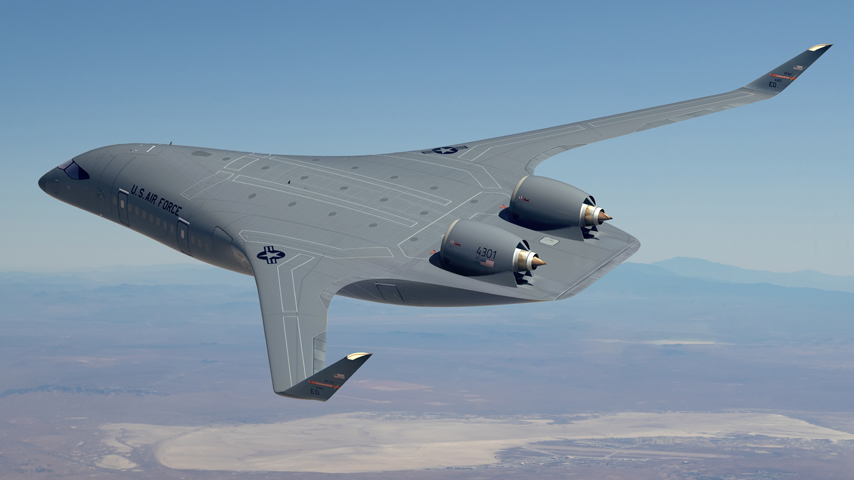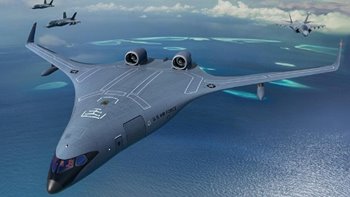Air Force Sees Promise in Blended Wing Body Aircraft
Air Force Sees Promise in Blended Wing Body Aircraft


To reduce fuel demand and increase global reach, the U.S. Department of the Air Force is working with aerospace manufacturer JetZero to build an innovative aircraft prototype.
Nearly 30 years ago, Mark Page, aerospace engineer and founder of JetZero, pioneered a unique aircraft concept while working under contract with the National Aeronautics and Space Administration (NASA). This innovative design smoothly united the wide body of the plane with high-lift wings in such a way that the entire aircraft contributed to the generation of lift—resulting in significantly reduced fuel demand. He called it the Blended Wing Body (BWB).
Now, the Air Force has contracted JetZero to build a working prototype of this groundbreaking aircraft.
Ravi Chaudhary, Assistant Secretary of the Air Force for Energy, Installations, and Environment, said he is excited to begin the prototype project on this “marvel of design engineering.” He said while the concept is not new, the technology required to execute its design requirements safely at scale is only now approaching maturity.
“Advancements in structural design, materials technology, manufacturing, and other areas were required before it could be considered viable for large-scale aircraft prototyping,” Chaudhary said. “Additionally, the commercial defense industry has become more interested in the development of emergency technologies and aircraft concepts, and we expect them to match funding for our prototyping effort.”
The Department of Defense plans to invest $235 million over the next four years to fast-track the prototype, which a JetZero spokesman said would be a “full-scale demonstrator—roughly the size of a Boeing 767.”
The new technologies required to support this type of design have already been extensively tested with the NASA X-48 and the Pultruded Rod Stitched Efficient Unitized Structure program and have demonstrated significant drag reduction and fuel-saving capabilities. But Chaudhary said he is also interested in how the new design may help the Air Force overcome the “tyranny of distance,” especially in regions such as the Indo-Pacific, where potential theaters of operation are further apart, requiring more capacity and more fuel.
“In an era where installations will no longer be a sanctuary, the blended wing technology could open up a host of new design advantages. It is no stretch to say that fuel use will be the margin of victory in a near-peer conflict,” he explained. “Ultimately, greater range increases lethality, fuel efficiency conserves our energy, and, together, this design should allow us to generate fewer sorties for the same size payloads. We may also find these aircraft make a lot less noise and are more compatible with hydrogen propulsion systems.”
Advances in Aerospace: NASA X-59 Supersonic Aircraft Assembles
The BWB aircraft, Chaudhary said, could be applied to a variety of different mission sets, including cargo, transport, tanker, and bomber aircraft designs.
“Incidentally, [these mission sets] makes up 60 percent of the fuel usage in the Air Force,” Chaudhary said. “Due to the significant increase in aerodynamic and structural efficiency, the BWB has the potential to increase fuel efficiency by 30 percent or more. A fleet of these could save the U.S. Department of the Air Force up to $1 billion in fuel costs per year.”
While the Air Force does not have any projections on the BWB’s potential efficiencies, Chaudhary said existing design data suggests the new craft could support missions ranging from aerial refueling to tankers.
“The BWB’s streamlined design has the potential to be significantly more efficient than existing designs, offering us more aircraft range, refueling capability, and cargo capacity,” he said. “That decreases our logistics risks and improves our readiness.”
Editor’s Choice: Quick Fixes to Aviation’s Emissions Problem
Chaudhary readily admits the design teams may face hurdles as they build the prototype – but he said all involved are working to anticipate any problems and address them before they become an issue.
 “Ironically, our blended wing design also requires a blended approach,” he said. “We have brought in experts from key agencies like NASA, as well as the top minds in academia to take a look at the aircraft and evaluate the design. We will do more of this during the prototyping effort. It will require a product-driven approach that examines flying qualities, human-machine interfaces, logistics capabilities, survivability, and much more. All of this will be critical to our success.”
“Ironically, our blended wing design also requires a blended approach,” he said. “We have brought in experts from key agencies like NASA, as well as the top minds in academia to take a look at the aircraft and evaluate the design. We will do more of this during the prototyping effort. It will require a product-driven approach that examines flying qualities, human-machine interfaces, logistics capabilities, survivability, and much more. All of this will be critical to our success.”
Chaudhary is excited to see what new knowledge the build of this “transformational technology” will bring to the Air Force. That knowledge gained, beyond the BWB, could lead to new developments to further increase fuel efficiencies and aircraft performance, improve logistics, and reduce the Air Force’s carbon footprint.
“When you push novel aircraft designs, there are a number of the benefits you designed for, but more opportunities should surface as knowledge of the system and how it performs grows,” he said. “The BWB effort is in the early stages of prototype development and aims to accelerate innovation and create opportunities for future capabilities.”
Kayt Sukel is a technology and business writer in Houston.
Now, the Air Force has contracted JetZero to build a working prototype of this groundbreaking aircraft.
Ravi Chaudhary, Assistant Secretary of the Air Force for Energy, Installations, and Environment, said he is excited to begin the prototype project on this “marvel of design engineering.” He said while the concept is not new, the technology required to execute its design requirements safely at scale is only now approaching maturity.
“Advancements in structural design, materials technology, manufacturing, and other areas were required before it could be considered viable for large-scale aircraft prototyping,” Chaudhary said. “Additionally, the commercial defense industry has become more interested in the development of emergency technologies and aircraft concepts, and we expect them to match funding for our prototyping effort.”
The Department of Defense plans to invest $235 million over the next four years to fast-track the prototype, which a JetZero spokesman said would be a “full-scale demonstrator—roughly the size of a Boeing 767.”
The new technologies required to support this type of design have already been extensively tested with the NASA X-48 and the Pultruded Rod Stitched Efficient Unitized Structure program and have demonstrated significant drag reduction and fuel-saving capabilities. But Chaudhary said he is also interested in how the new design may help the Air Force overcome the “tyranny of distance,” especially in regions such as the Indo-Pacific, where potential theaters of operation are further apart, requiring more capacity and more fuel.
“In an era where installations will no longer be a sanctuary, the blended wing technology could open up a host of new design advantages. It is no stretch to say that fuel use will be the margin of victory in a near-peer conflict,” he explained. “Ultimately, greater range increases lethality, fuel efficiency conserves our energy, and, together, this design should allow us to generate fewer sorties for the same size payloads. We may also find these aircraft make a lot less noise and are more compatible with hydrogen propulsion systems.”
Advances in Aerospace: NASA X-59 Supersonic Aircraft Assembles
The BWB aircraft, Chaudhary said, could be applied to a variety of different mission sets, including cargo, transport, tanker, and bomber aircraft designs.
“Incidentally, [these mission sets] makes up 60 percent of the fuel usage in the Air Force,” Chaudhary said. “Due to the significant increase in aerodynamic and structural efficiency, the BWB has the potential to increase fuel efficiency by 30 percent or more. A fleet of these could save the U.S. Department of the Air Force up to $1 billion in fuel costs per year.”
While the Air Force does not have any projections on the BWB’s potential efficiencies, Chaudhary said existing design data suggests the new craft could support missions ranging from aerial refueling to tankers.
“The BWB’s streamlined design has the potential to be significantly more efficient than existing designs, offering us more aircraft range, refueling capability, and cargo capacity,” he said. “That decreases our logistics risks and improves our readiness.”
Editor’s Choice: Quick Fixes to Aviation’s Emissions Problem
Chaudhary readily admits the design teams may face hurdles as they build the prototype – but he said all involved are working to anticipate any problems and address them before they become an issue.

Volunteers Are the Heart of ASME
Volunteering at ASME offers a wide spectrum of opportunities for personal and professional growth.
Chaudhary is excited to see what new knowledge the build of this “transformational technology” will bring to the Air Force. That knowledge gained, beyond the BWB, could lead to new developments to further increase fuel efficiencies and aircraft performance, improve logistics, and reduce the Air Force’s carbon footprint.
“When you push novel aircraft designs, there are a number of the benefits you designed for, but more opportunities should surface as knowledge of the system and how it performs grows,” he said. “The BWB effort is in the early stages of prototype development and aims to accelerate innovation and create opportunities for future capabilities.”
Kayt Sukel is a technology and business writer in Houston.








.png?width=854&height=480&ext=.png)